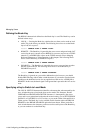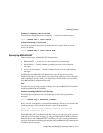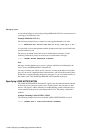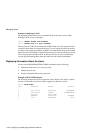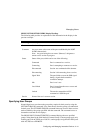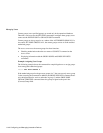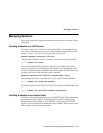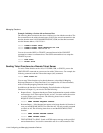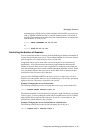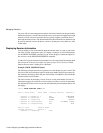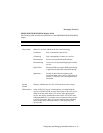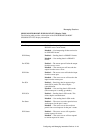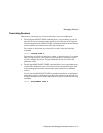
Managing Sessions
11-44 Configuring and Managing Interactive Devices
Example: Initiating a Session with an Internet Host
The following three commands show how to initiate a session with the same host. The
first command uses the relative domain name, SALES; the second command uses the
absolute domain name SALES.MARKETING.DEC.COM; and the third command
uses the Internet address, 129.122.30.11.
Local> CONNECT TELNET SALES
Local> CONNECT TELNET SALES.MARKETING.DEC.COM
Local> CONNECT TELNET 129.122.30.11
You can also use the OPEN or TELNET command instead of the CONNECT
command to connect to an Internet host. The OPEN command does not accept the
TELNET keyword.
Local> OPEN SALES
Local> TELNET SALES
Sending Telnet Functions to a Remote Telnet Server
To send a Telnet function such as AO, AYT, BRK, EOR, or SYNCH, you use the
SEND TELNET command on a current session with a Telnet server. For example, the
following command sends the Telnet abort output (AO) command:
Local> SEND TELNET AO
You can map Telnet functions to keyboard characters as described in Mapping
Keyboard Characters to Telnet Functions. For a complete list of Telnet commands,
refer to Telnet Keymapping Functions in this chapter.
In addition to the functions listed in Mapping Event Indications to Keyboard
Characters in Chapter 13, you can also send the following:
•
Request Status — Requests that the peer Telnet implementation responds with the
current status of all Telnet options for this session. You must resume the session
to see the Telnet server’s response. The following shows how to send the
REQUEST STATUS function:
Local>
SEND TELNET REQUEST STATUS
•
Resume Output — If the Internet host appears to be hung after the AO function is
sent, you send RESUME OUTPUT to cancel the AO. You only use this command
to cancel an AO. The following shows how to send the RESUME OUTPUT
function:
Local>
SEND TELNET RESUME OUTPUT
Local>
SEND TELNET SYNCH
•
TEST INTERNET or PING - Sends an ECHO request message to the specified
remote Internet host. You use this command to test for a valid connection. This



